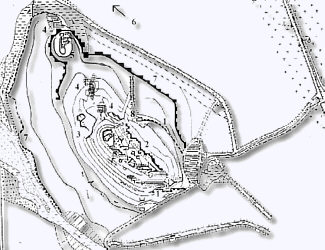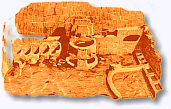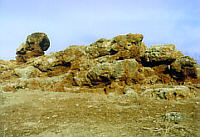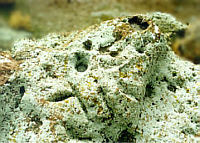Metsamor 2: Museum | Ground Floor | Upstairs | Lower Level | Gold Rooms
Metsamor 3: Excavation | Temple | Observatory | Getting Back
download Arial AM font
 |
1. Cyclopic Walls. 2. Old Citadel and round dwellings 3. Temple site 4. Foundry 5. Upper Citadel 6. Observatory 7. Outer walls 8. Mediaeval Precinct |
1. Cyclopic Walls
The cyclopic walls date from the 2nd millennium BC, fortified during the
Urartian Era. The stone blocks average 20 tons in weight, more than
3 meters thick.
2. Old Citadel and round dwellings
The Old citadel was the first to be excavated at the site, and is the
probably location of heretofore undoscovered archives. When uncovered,
the area showed a complex of round house dwellings, temples and palace
structures, dating back to the 4th millennium BC.
En route to the Temple Site, just below the old citadel, is an incline on the stone hill. Carved into the hill is an intricate and large (almsot 20 meters long) design. The design resembles a rudimentary map, and the shape of the rock resembles the Ararat side of Mt. Aragats in miniature. Inscriptions also include several early Haikassian script symbols (though carved at Metsamor much earlier, ca. 3000 BC), and forms one of the basis' for establishing the old Armenian script during the Bronze Age around Metsamor.
3. Temple site
 Three
temples were uncovered and are covered by a metal structure. Vandals
have desecrated most of the altars you see. Luckily they are only
three of an entire complex that was preserved by recovering them after
the initial dig in 1967. The temples are unlike any other
uncovered in Western Asia and the Ancient world, indicating a very distinct
culture at Metsamor during the 2nd-1st millennia.
Three
temples were uncovered and are covered by a metal structure. Vandals
have desecrated most of the altars you see. Luckily they are only
three of an entire complex that was preserved by recovering them after
the initial dig in 1967. The temples are unlike any other
uncovered in Western Asia and the Ancient world, indicating a very distinct
culture at Metsamor during the 2nd-1st millennia.
Within the altar spaces are numerous bowls set into the temple floor and a complex series of clay holders. Very little is understood about the ritual that occured here, though animal sacrifice was a part. The holders probably held rare oil mixed with myrrh and frankincense, purified wine, wheat and fruit (seeds were discovered in some of the shallow bowls).
4. Foundry
The foundry dates from the Early Bronze Age (ca. 4000 BC), though recent
digs in the area uncovered signs of metal processing as early as 5000
BC. The complex of smelting furnaces and molds around you date from
the mid Bronze to Early Iron Age (3000-2000 BC). The complex becomes
more astounding the more you walk through it. Several huge undergournd
caves were uncovered that are thought to have been storehouses for base
metal, as well as a grainery for winter months. Stretching just
below and around the Upper Citadel, the foundries processed Copper, Bronze,
Iron, Mercury, Manganeze, Strychnine, Zinc and gold. The first iron
in the ancient world was probably forged here, though it was not considered
as important as bronze, giving the jump on development to the Babylonians.
5. Upper Citadel
The Upper citadfel is covered over, except for a few pits. The main
building was the city palace or main temple. The inner walls ring
the site on three sides, with the foundries kust below.
 6. Observatory
6. Observatory
The observatory rivals the discoveries at the citadel for importance,
subtstantiating therories on the birthplace of the zodiac and orgins of
astronomy in the ancient world. Dated ca. 2800-2500 BC, when the
zodiac is figured to have been concluded, the observatory was also the
primary religious site and navigation center for the Metsamorian culture.
Hundreds of shallow bowls are carved onto the surfaces of three large
rocks that rise above the surrounding river delta. The use of the
bowls are unknown, many are linked by equally shallow "canals" (we're
talking real small here, no more than a few inches in diameter for the
bowls). They might have been filled with oil that was lit at night
as part of a ritual celebration (if so, they would look very much like
a 'bowl of the universe' on earth), or they may have been used to
smelt and forge metal in another sort of ritual. Imagination allows
you to decide for yourself.
 You
need to be very careful while exploring the observatory site, since the
inscriptions are carved on basalt and tuf, and have already been eroded
by exposure to the elements since uncovered in 1967. For more information
on the site, see The
First Astronomers?
You
need to be very careful while exploring the observatory site, since the
inscriptions are carved on basalt and tuf, and have already been eroded
by exposure to the elements since uncovered in 1967. For more information
on the site, see The
First Astronomers?
7. Outer walls
The outer walls are 2nd-1st millennium BC, laid during Urartian times.
The walls mark the greatest extent o fthe ancient citadel, though the
necropolis and graveyard extend for another 200 hectares intonearby Taronik
Village.
8. Mediaeval Precinct
The Medieval Precinct was located on top of the old citadel. The
discovery of medieval coins and artifacts there prompted the 1967 excavation.
Foundations were removed to uncover the older layers of the city.
Getting Back
From Metsamor, turn L on the Taronik Road (away from Taronik), and
travel past the Motel (1.5 kilometers). 500 meters past the motel
there will be a fork in the road, veer to the R and continue to the Echmiadzin
Highway (1 kilometer). To return to Yerevan, turn R (itís 33 kilometers
to Opera Square from here, 13 kilometers to the Hripsimeh Church intersection
in Echmiadzin). To continue onto Sardarabat, Hoktemberian or Giumri,
turn L.